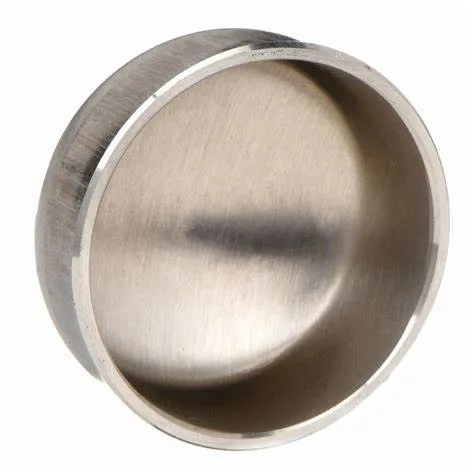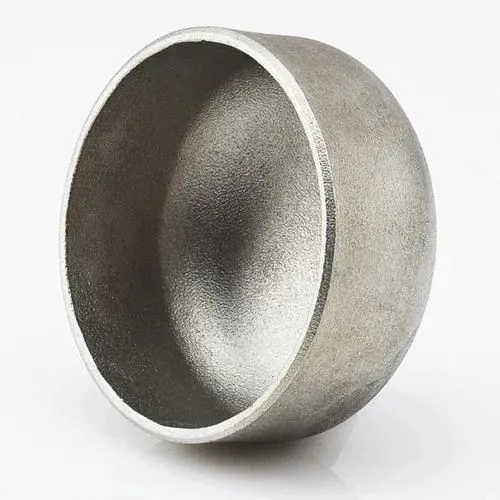ʻO JIS B2311 kahi Kūlana ʻOihana Kepanī e uhi ana i nā mea hoʻopili paipu butt-weld, me nā pāpale i hoʻohana ʻia i nā ʻōnaehana paipu. ʻO nā pāpale wili puʻupuʻu ke kumu o ka pani ʻana i ka hopena o kahi paipu, e hāʻawi i kahi sila e pale ai i ka leakage a i ʻole ka haumia. Eia ka hoʻolauna ʻana i nā pāpale wili-weld JIS B2311:
- 1. JIS B2311 Standard:
- - Hōʻike ka maʻamau JIS B2311 i nā koi no ka hoʻolālā, nā ana, nā mea hana, ka hana ʻana, a me ka hoʻāʻo ʻana i nā mea hoʻopili butt-weld, me nā pāpale, i nā ʻōnaehana paipu.
- - Hōʻoia ka maʻamau i nā pāpale i hana ʻia e like me nā kūlana JIS e hoʻokō i nā kūlana maikaʻi a kūpono hoʻi me nā ʻāpana paipu ʻē aʻe.
- 2. Pāleʻa Puʻupuʻu:
- - ʻO kahi pāpale wili-weld, e like me JIS B2311, he mea kūpono i hoʻolālā ʻia e uhi a hoʻopaʻa paʻa i ka hopena o kahi paipu me ka palekana, e hāʻawi ana i ka pale a mālama i ka pono o ka ʻōnaehana paipu.
- - Hoʻohana ʻia nā pāpale i nā kūlana e pani ʻia ai ka hopena o ka paipu, no ka manawa mau a i ʻole no ka manawa pōkole, e pale ai i ka leakage, contamination, a i ʻole e hoʻopau i ka ʻōnaehana.
- 3. Mea a me ka hana:
- - Loaʻa nā pāpale butt-weld ma lalo o nā kikoʻī JIS B2311 i nā mea like ʻole e like me ke kila kalapona, ke kila kila, a me ke kila kila e hoʻokō i nā koi noi like ʻole.
- - Hana ʻia kēia mau pāpale me ka hoʻohana ʻana i nā ʻano hana maʻamau no ka hōʻoia ʻana i kahi pilina ikaika a me ka leak-leak ke hoʻopaʻa ʻia i ka hopena o kahi paipu.
- 4. Noi a me na pomaikai:
- - Loaʻa i nā pāpale wili puʻupuʻu i nā noi ma nā ʻoihana like ʻole, me ka ʻaila a me ke kinoea, nā kaʻina hana kemika, nā mea kanu mālama wai, a me nā mea hou aku kahi e pono ai e hoʻopaʻa paʻa ʻia nā hopena paipu.
- - Hāʻawi nā pāpale i ka pale i nā hopena o ka paipu mai nā mea kaiapuni, pale i ka haumia, a kōkua i ka mālama ʻana i ka maʻemaʻe a me ka pololei o ka ʻōnaehana paipu.
- 5. Hoʻokomo a me ka welding:
- - Pono nā hana hoʻonohonoho kūpono, me ka hoʻopololei pololei, ka hoʻomākaukau ʻana i ka hopena o ka paipu, a me nā ʻenehana wili, he mea nui i ka wā e hoʻokomo ai i nā pāpale wili-weld e hōʻoia i kahi sila paʻa a leak-proof.
- - He ala maʻamau ka welding no ka hoʻopili ʻana i nā pāpale i nā paipu, e hāʻawi ana i kahi pani paʻa a paʻa i hiki ke kū i ke kaomi, nā ʻano like ʻole o ka mahana, a me ke kahe wai i loko o ka ʻōnaehana.
- I ka hōʻuluʻulu ʻana, ʻo JIS B2311 butt-wellding caps he mea koʻikoʻi i hoʻohana ʻia i nā ʻōnaehana paipu e sila a pale i ka hopena o nā paipu me ka palekana. Hoʻopili kēia mau pāpale i nā koi maʻamau e hōʻoia i ka maikaʻi, hilinaʻi, a me ka hoʻohālikelike ʻana i loko o nā noi ʻoihana kahi e pono ai ka pani ʻana o ka paipu a me ka pale.
What Is a Butt Welding Cap and How Is It Used in Industrial Piping?
In industrial piping systems, end-of-line sealing and branch closures require robust solutions. A butt welding cap serves as a critical component for terminating pipes securely. By providing a seamless, welded closure, this fitting maintains system integrity, prevents leaks, and supports compliance with industry standards.
What Is a Butt Welding Cap?
A butt welding cap—also called a pipe end cap or buttweld end cap—is a round fitting designed to close off the end of a pipe. It’s manufactured to match the pipe’s outer diameter and schedule, with either a hemispherical or flat face. To install, both the pipe end and cap are beveled to form a V‑groove, enabling full‑penetration, fusion welds. Common materials include carbon steel, stainless steel, nickel alloys, and other engineered grades, chosen to satisfy pressure, temperature, and corrosion‑resistance requirements.
How Is Butt Welding Cap Used in Industrial Piping?
Butt welding caps find application across oil & gas, petrochemical, power generation, water treatment, and general process industries for both permanent and temporary closures. During hydrostatic testing, technicians install caps to seal off sections of piping while monitoring for leaks. In new construction or retrofit projects, caps terminate branch lines, future tie‑in spools, or dead‑end mains until system expansion. Welders prepare each joint by cleaning and beveling surfaces, aligning the cap precisely, and executing a root pass followed by filler passes per the qualified Welding Procedure Specification (WPS). Post‑weld heat treatment and non‑destructive examination (NDE)—such as radiography or ultrasonic testing—verify weld integrity and compliance with ASME B16.9 and related standards. Additionally, temporary caps enable safe isolation during maintenance, allowing for segment testing and dewatering under regulatory protocols.
Benefits and Best Practices
Butt welding caps offer a smooth‑bore transition that minimizes flow disruption and stress concentration. Their full‑penetration welds deliver exceptional structural strength and leak resistance. To optimize performance, engineers should:
Select caps with matching material grades and wall thicknesses
Adhere to proper bevel angles and joint fit‑up tolerances
Follow qualified WPS protocols rigorously
Consider cladding or protective coatings in corrosive environments to extend service life
Regular inspection and thorough documentation ensure long‑term reliability and safe operation under demanding conditions.
Butt welding caps are indispensable components for achieving durable, leak‑proof pipe terminations in a wide range of industrial applications.
Butt Welding Cap FAQs
What is a butt welding cap?
|
What materials are commonly used?
|
What standards govern butt welding caps?
|
How are butt welding caps installed?
|
Where are butt welding caps typically used?
|
What are the advantages of threaded caps?
|
















